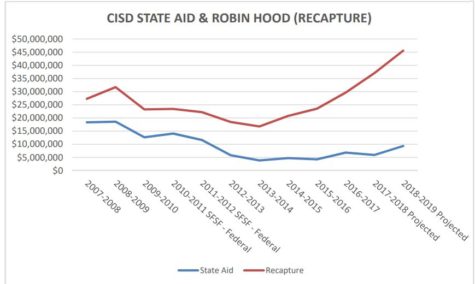Political signs are lined along the road to Coppell Town Center on Sunday, Nov. 4 for the upcoming mid-term election on Nov. 6. This election will determine which candidates will be elected at the local, state, and congressional level.
Part 4: The search for the solution to CISD’s funding dilemma
November 2, 2018
This election season, public education funding has found a place among the most prominent topics in Texas.
For the past several years, wealthy districts – such as Coppell ISD – have been trapped in a predicament between clashing financial state government laws, making funding and budgeting a challenge.
One of the biggest causes of this issue is the increasing recapture, commonly called the Robin Hood state program, taken from CISD by the state. Created in 1993, its goal was to allow the state to redistribute school tax revenue from high property value districts to districts with low home value and therefore bring balance throughout the state. It was initially successful, striking a balance between funding for wealthy and needy districts in Texas for more than a decade.
This program meant less funding for Coppell ISD. However, over the years, state funding for CISD became a fraction of what it used to be, as the state of Texas expects the money from the rising high-value property taxes will fill the hole. Therefore, CISD’s funding went from the planned 50- 50 state funding and local contributions to only 10.8 percent coming from the state, according to CISD. To put things into perspective, CISD also gave 26.7 percent of its total funds as recapture at the same time.
 Courtesy: CISD
Courtesy: CISD
With the rapidly growing student population, CISD’s funds struggle to keep up with its costs. CISD is expected to keep educating a swiftly increasing population while its state aid lies stagnant, leading to less money to spend on its students.
This short informational video from Raise Your Hand Texas further explains the situation.
CISD Trustee Manish Sethi hopes to see changes in public school funding and the Robin Hood law following the midterm elections.
“We want the elected officials [in the midterms] to support us and rethink funding for public education so they can increase the money coming from the state,” Sethi said. “[State funding] has gone down considerably compared to the last six to seven years, this trend will not be sustainable forever.”
Another campaign topic is the school voucher system. While often repackaged under different names, the general concept of a school voucher is the same: money paid by the local taxpayers supporting private schools instead of public.
While most Democrats, such as U.S. Senate candidate Beto O’Rourke, have openly criticized and promised changes to the voucher system in place, Republicans, namely O’Rourke’s rival Ted Cruz, have been an avid supporter of it and plan to keep it. But for CISD, a public school district, the weakening of the vouchers law is the preferred outcome as it allows more money to flow to CISD.
A school’s facilities, teachers and extracurricular opportunities all indirectly depend on receiving the necessary funding. In the end, the funds of a school can be the defining factor of the quality of education. Therefore, a decrease in funding for Coppell could most likely be proportional to the state of education for its students, placing itself in the center of a key debate by politicians.
David Royer is a Coppell voter and the father of two CISD students.
“Public education has to have the right support in place to ensure the students have equal opportunities in school to succeed,” Royer said. “And that they are also given the right resources to develop academically so that they are not restricted in their academic pursuits, allowing them to set their own goals and standards. Public schools should also become an extension of home values and should have the right emotional support.”
Royer also thinks an adequate number of teachers is a characteristic of a good school.
“I would like to see a better student to teacher ratio,” Royer said. “Since CISD is getting bigger, [the student to teacher ratio] also needs to be grow accordingly.”
The midterms determine the future of Texas and its students for the next two years, different candidates have different goals in mind regarding educational funding in Texas. The outcome of this years midterm elections may bring change in the education system, and CISD hopes it to be for the betterment of its funding.
